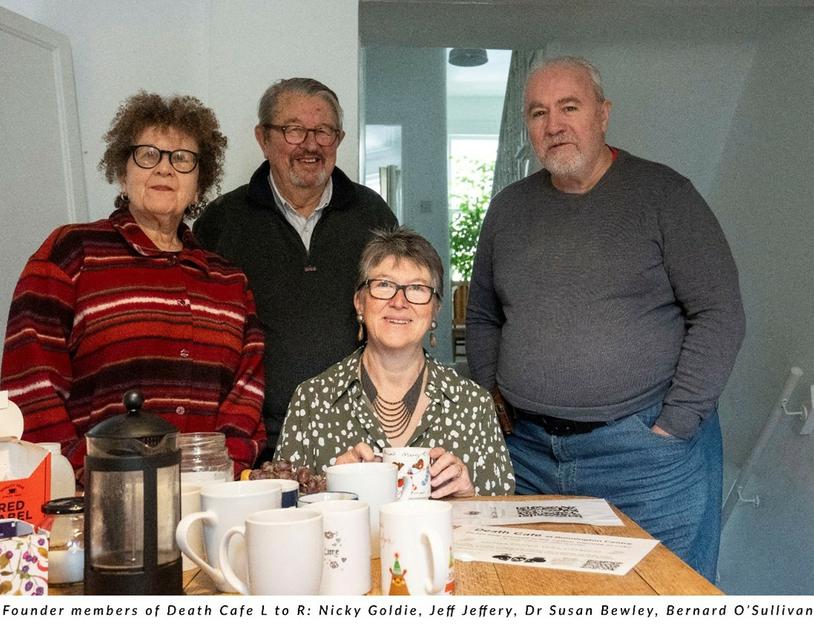Using social media to support an in-person Death Cafe
 Posted by
Bonnington Centre Death Cafe
Posted by
Bonnington Centre Death Cafe

Using social media to support an in-person Death Cafe Following why and how we set up a Death Café, this is a blog about our two-year experience of using WhatsApp. We created two groups in order to support the face-to-face Death Cafe discussions: one was for the facilitators, and the other for attendees. Administration Looking back on our postings, it’s clear that the facilitator WhatsApp group mostly covers practicalities with the Community Centre and general chat - where we ‘check-in’ with one another. What’s the rota, who’s bringing fresh milk, and is the heating working? When one or more of us are unwell or away, who’s got the keys and were there any problems? On top of this continuous communication we also arrange more formal quarterly face-to-face off-site Admin Meetings outside the Death Cafe schedule. Here we talk about dates to be uploaded on the website, what’s working well (or not), and we drew up and amend an internal ‘How to Facilitate’ guidance document. We usually set three months’ worth of fortnightly dates in advance. We advertise by the Death Cafe website, a poster in the community centre, local networks such as Next Door or residents’ associations, and word of mouth. As the room space is limited, we’re content with the mixture of ‘hard-core’, regulars, occasional and ‘dip-in’ attendees. Sharing resources The attendee WhatsApp group took off after a couple of months of meetings. We started by manually adding regulars and then created a laminated QR code to invite all newcomers with a smartphone. Its first function is to remind everyone of forthcoming sessions. It allows attendees to alert the group about potential disturbances of arriving late or needing to leave early. Mostly, it’s used by people to post items of interest that augment and complement what was discussed at each session. Between meetings, people might also post links to interesting, news articles, films, books, radio and TV programmes. The fortnightly Death cafes themselves usually consist of 6-12 people. Our room can just about fit 12-15 people (with emergency plans to either split six off into the kitchen if we are ever overfull or to let latecomers sit on the floor - luckily neither ever needed!). Yet, after two years, the WhatsApp group has collected over 60 members and less than five left, suggesting some continuing value even without attendance. Commentary beyond minimal emojis is generally signposted back to the next Death Cafe, given how precious we find the thoughtful togetherness created by respectful listening. Meeting face-to-face encourages genuine, non-partisan, diverging, free speech and civil handling of some profound disagreements. We somewhat discourage interaction on social media as we rarely find such deep and difficult discussions on large social media groups. It’s too easy to mis-step, to misunderstand or be misunderstood. We don’t wish to get drawn into arguments or be unwilling spectators of ‘shouting’ matches . The postings are thus a rich and eclectic set of resources to draw upon. Books and thought provoking book reviews have been recommended, such as One Last Thing: how to live with the end on mind, The Tibetan Book of Living and Dying Regrets of the Dying and In Love: a memoir of love and loss. A Beginners Guide to Dying gave advice for loved ones, Döstädning introduced us to the Swedish art of Death Cleaning and Dying Tidily to preparation. The Madness of Grief described Sadmin - the bureaucratic work afterwards. Films from all imaginative genres, such as Harold and Maude, The Death of Stalin, Alone in Berlin, The Event, The Hunger and Life after Death provided scenes we recalled or retold how they moved us. Documentaries included one on a child dying with sepsis and another about the last remains of the mentally ill collected in an art book Library of Dust. Articles, videos and podcasts have been shared about living, for example with grief, terminal illness, or debilitating conditions such as Huntingdon’s Chorea or dementia. We are amazed by the global variety of ancient rituals from Mexico to modern day China and in Romany Gypsy, Roma and Traveller communities. We’ve talked about near-death experiences, methods of disposal and end of life doulas. The Hajj, panentheism and necropolitics have cropped up. Death Cafés have even been researched. Of course, we return frequently to palliative care, assisted dying for and against, and euthanasia, London is spoiled for events, theatres, museums, art exhibitions and creative memento mori workshops. Walks and themed tours take place regularly around grand Victorian cemeteries like West Norwood, Abney Park and Highgate. Death Café attendees have sometimes arranged to meet separately to go to a public lecture or play, a spiritual reading, or religious workshop and will return with reports that stimulate further discussion. In summary The quiet WhatsApp group supports our conversations and thinking. Deliberately keeping the volume of social media traffic down means that people aren’t irritated by constant ‘pings’. Those who don’t (or can’t) use smartphones are not left out. Likely, the occasional or one-off attenders still feel connected, but muse or reflect on death at their own pace. Visitors to this main website – whether they’ve ever attended a cafe or not - may find some of the hyperlinked resources of interest. My fellow facilitators and I hope the blog may stimulate more people to visit a Death Cafe, or even set up their own. There’s so much more out there to explore and discuss over tea and cake.
